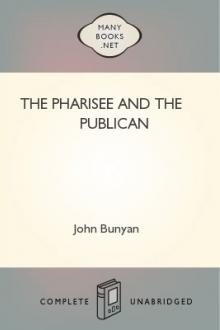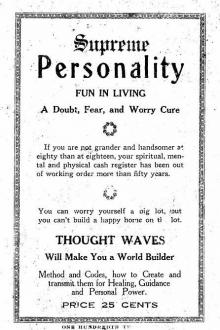Science and the Infinite, Sydney T. Klein [well read books TXT] 📗

- Author: Sydney T. Klein
- Performer: -
Book online «Science and the Infinite, Sydney T. Klein [well read books TXT] 📗». Author Sydney T. Klein
The first step to a clear understanding of this, is to recognise that it is not we who are looking out upon Nature but that it is the Reality which is ever trying to enter and come into touch with us through our senses, and is persistently trying to waken within us a knowledge of the sublimest truths. It is difficult to realise this, as from infancy we have been accustomed to confine our attention wholly to the objective, believing that to be the reality.
Let us try and grasp this fact. If we analyse our sense of sight, we find that the only impression made on our bodies by external objects is the image formed upon the retina; we have no cognisance of the separate electro-magnetic rills forming that image, which, reflected from all parts of an object, fall upon the eye at different angles, constituting form, and with different frequencies giving colour to that image; that image is only formed when we turn our eyes in the right direction to allow those rills to enter; and, whereas those rills are incessantly beating on the outside of our sense organ when the eyelid is closed, they can make no impression unless we allow them to enter by raising that shutter. It is not then any volition from within that goes out to seize upon and grasp the truths from Nature, but the phenomena are as it were forcing their way into our consciousness. This is more difficult to realise when the object is near to us, as we are apt to confound it with our sense of touch, which requires us to stretch out our hand to the object, but it is clearer when we take an object far away. In our telescopes we catch the rills of light which started from a star a thousand years ago and the image is still formed on the retina now although those rills are in fact a thousand years old and, invisible to our unaided eye, have been falling upon mankind from the beginning of life on this globe, trying to get an entrance to consciousness. It was, however, only when, by evolution of thought, the knowledge of optics had produced the telescope that it became possible not only for that star to make itself known to us but to declare to us its distance, its size, and conditions of existence, and even the different elemental substances of which it was composed a thousand years ago. Yet, when we now allow its image to form on the retina, our consciousness insists on fixing its attention upon that star as an outside object, refusing to allow that it is only an image inside the eye and making it difficult to realise that that star may have disappeared and had no existence for the past 999 years, although in ordinary parlance we are looking at and seeing it there now.
I have referred above to the sense of touch; it is, I think, clear that the first impression a child can have of sight must take the form of feeling the image on its retina, as though the object were actually inside the head, and it could have no idea that it was outside until, by touching with the hand, it would gradually learn by experience that the tangible outside object corresponded with the image located in the head; this is fully borne out by the testimony of men who, born blind, have, by an operation, received their sight late in life; in each case their first experience of seeing gave the impression that the object was touching the eye, and they were quite unable to recognise by sight an object such as a cup or plate or a round ball which they had commonly handled and knew perfectly well by touch; in fact, the idea of an object formed by the sense of touch is so absolutely different to that formed by the sense of sight that it would be impossible without past experience to conclude that the two sensations referred to one and the same object. The image formed on the retina has nothing in common with the sense of hardness, coldness, and weight experienced by touch, the only impression on the retina being that of colour or shade, and an outline; it is, however, hardly conceivable that even the outline of form would be recognised by the eye until touch had proved that form comprised also solidity and that the two ideas had certain motions in common both in duration in Time and extension in Space.
Again, our senses of sight and hearing are alike based on the appreciation of frequencies of different rapidity; brightness and colour in light are equivalent to loudness and pitch in sound, but in sound we have no equivalent to perception of form or situation in space; it gives us no knowledge of the existence of objects when situated at great distances, nor can movements be followed even at short distances without having material contact, by means of the air, with the object; sight indeed appears to have to do with Space- and sound with Time-perception. In examining Nature by means of our senses we find we are so hemmed in by what we have always taken for granted and so bound down by modes of reasoning derived from what we have seen, heard, or felt in our daily life, that we are sadly hampered in our search after the truth. It is difficult to sweep the erroneous concepts aside and make a fresh start. In fact the great difficulty in studying the Reality underlying Nature is analogous to our inability to isolate and study the different sounds themselves which fall upon the ear, if our own language is being uttered, without being forced to consider the meaning we have always attached to those sounds.
Let us now go back to the contention that it is not we who are looking out upon Nature but that our senses are being bombarded from without; we are living in a world of continuous and multitudinous changes, and as our senses require change or motion for their excitation, without those changes we could have no cognisance of our surroundings, we should have no consciousness of living; but if we base our thought entirely on sense perception, taking for granted that Time and Space have reality instead of recognising that they are only modes or limits under which those senses act, the Wall will ever remain opaque to us. Let us try and make this clearer. If we analyse the impression we receive from Motion, we find it is made up of the product of our two limitations, it is the time that an object takes to go over a certain space. We must come therefore to the conclusion also that Motion itself has no existence in reality apart from our senses. The result of not being able to appreciate this, is that the finiteness of our sense, caused by its dependence on Motion for excitation, surrounds us with illusions; one of these illusions is what we call solidity or continuity of sensation. If you hold a cannon-ball in your hand, perception by the sense of touch tells you that it is continuous, or what is called solid and hard; but it is not so in reality except as a concept limited by our finite senses. A fair analogy would be to liken it to a swarm of bees, for we know that it is composed of an immense number of independent atoms or molecules which are darting about, and circling round each other at an enormous speed but never touching; they are also pulsating at a definite enormous rate; we can at will increase their motion by heat or reduce by cold; if our touch perception were sensitive enough we should feel those motions and should not have the sensation of a solid. We have a similar case of limitation in our other senses, which we shall grasp better in another View through our Window. We can hear beats only up to fifteen in a second, beyond that number they give the sensation of a musical or continuous sound. In our sense of sight we can see pulsations or intermittent flashes up to only six in a second, beyond that number they give the sensation of a continuous light; a gas jet, if extinguished and relit six times in a second, can be seen to flicker, but beyond that rate is to our sense of sight a steady flame. The effect may also be shown by making the top of a match red-hot; when stationary or moving slowly, it is a point of light, but, moved quickly, it becomes a continuous line of light.
Even apart from our senses we find Motion giving the characteristics of solidity: a wheel with only a few spokes, if rotated quickly enough, becomes quite impermeable to any substance, however small, thrown at it; a thin jet of water only half an inch in diameter, if discharged at great pressure equivalent to a column of water of 500 metres, cannot be cut even with an axe, it resists as though it were made of the hardest steel; a thin cord, hanging from a vertical axis, and being revolved very quickly, becomes rigid, and if struck with a hammer it resists and resounds like a rod of wood; a thin chain and even a loop of string, if revolved at great speed over a vertical pulley, becomes rigid and, if allowed to escape from the pulley, will run along the ground as a hoop.
Now with regard to this limit of time perception, which gives us the phenomenon of Solidity, I have lately been able to devise an arrangement which, acting as a microscope for Time, gives the sensation of an increase in sight perception up to several thousand units per second; it is based on the fact that though the eye can only see six times per second it can see for the one-millionth part of a second. An example of this is the well-known experiment of seeing a bullet in its flight; the bullet makes electrical connection resulting in a spark which illuminates the bullet when opposite the eye. The electrical spark exists only for the millionth of a second, and as the bullet in that time has no perceptible movement it is seen standing absolutely still with all marks upon it quite visible to the eye. When Sight perception is increased up to the rate at which time may be said to flow for any particular object we apparently get into the reality, the permanent now where motion ceases to exist as a sensation. A tuning-fork, kept vibrating, by means of an electro-magnet, at 2000 times per second, may to our sense of sight be gradually slowed down and, optically, brought absolutely to a standstill, for as long as desired, and the smallest irregularity of its surface may be minutely examined, though it continues to be heard and felt vibrating at that enormous rate. I have made several experiments in this direction, and some very





Comments (0)